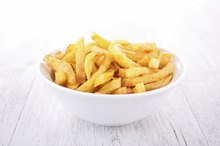What does fact checked mean?
At Healthfully, we strive to deliver objective content that is accurate and up-to-date. Our team periodically reviews articles in order to ensure content quality. The sources cited below consist of evidence from peer-reviewed journals, prominent medical organizations, academic associations, and government data.
- American Heart Association: Overweight in Children
- American Heart Association: Sodium (Salt or Sodium Chloride)
The information contained on this site is for informational purposes only, and should not be used as a substitute for the advice of a professional health care provider. Please check with the appropriate physician regarding health questions and concerns. Although we strive to deliver accurate and up-to-date information, no guarantee to that effect is made.
Diseases From Eating Unhealthy School Lunches
A problem with lunches in U.S. schools is their poor nutritional quality. Most schools provide processed foods which are high in fat, salt and sugar. This is already having a major adverse impact on children’s health. Unhealthy school lunches can lead to diseases such as obesity, heart disease, stroke, high blood pressure, diabetes and liver disease.
Obesity
The American Heart Association estimates that around one in three children and adolescents in the United States are overweight or obese 12. This puts childhood obesity in the No. 1 spot for children’s health problems. Unhealthy school lunches play a significant role because many of them contain foods that are high in saturated fats; foods such as French fries, fried chicken, pizza, hotdogs and processed cheese. Obesity can lead to other diseases such as type 2 diabetes, heart disease, high blood pressure, as well as promoting a negative body image and low self-esteem.
- The American Heart Association estimates that around one in three children and adolescents in the United States are overweight or obese 1.
- Unhealthy school lunches play a significant role because many of them contain foods that are high in saturated fats; foods such as French fries, fried chicken, pizza, hotdogs and processed cheese.
Heart Disease
What Is an Atherogenic Diet?
Learn More
Processed foods, such as those found in some school lunches, tend to be high in sodium. The American Heart Association reports that diets high in sodium can lead to heart disease as well as high blood pressure and stroke 12. Foods high in sodium that are likely to be found in school lunches include condiments such as salad dressings and ketchup, tomato sauce, canned foods and prepackaged food mixes.
Diabetes
Over the past 10 years, the incidence of type 2 diabetes in children has increased by 150 percent. Unhealthy school lunches may be a contributing factor because many processed food are high in fructose and corn syrup, which can lead to type 2 diabetes.
Liver Disease
School Lunches Vs. Fast Food
Learn More
Children who eat school lunches comprising mostly processed foods are at elevated risk for fatty liver disease. Processed foods such as white rice, foods containing refined flour and whole grains which have been processed can cause the body to release insulin more rapidly than it is needed. This increases fat deposition on the body and in the blood and the liver. The main culprits are processed foods that are high in starch such as foods containing white flour and white rice, and foods containing whole grains that have been overrefined.
- Children who eat school lunches comprising mostly processed foods are at elevated risk for fatty liver disease.
- Processed foods such as white rice, foods containing refined flour and whole grains which have been processed can cause the body to release insulin more rapidly than it is needed.
Related Articles
References
- American Heart Association: Overweight in Children
- American Heart Association: Sodium (Salt or Sodium Chloride)
- Health Breakthroughs: Don’t Let Your Child Become a Statistic: Beat the Diabetic Epidemic
- American Heart Association. Sources of Sodium.
- Centers for Disease Control and Prevention. Top 10 Sources of Sodium. 2017.
- Institute of Medicine. Dietary Reference Intakes Tables and Application. National Academies of Sciences, Engineering, and Medicine, Health and Medicine Division. 2015.
- United States Department of Agriculture. Dietary Guidelines for Americans 2015–2020. United States Department of Health and Human Services. 2015.
Writer Bio
Corinna Underwood began writing in 2000. She has been published in many outlets, including Fox News, “Ultimate Athlete,” “Hardcore Muscle,” “Alternative Medicine” and “Alive.” Underwood also wrote "Haunted History of Atlanta and North Georgia" and "Murder and Mystery in Atlanta." She has a Bachelor of Arts in English literature and philosophy and a Master of Arts in women’s studies from Staffordshire University.









